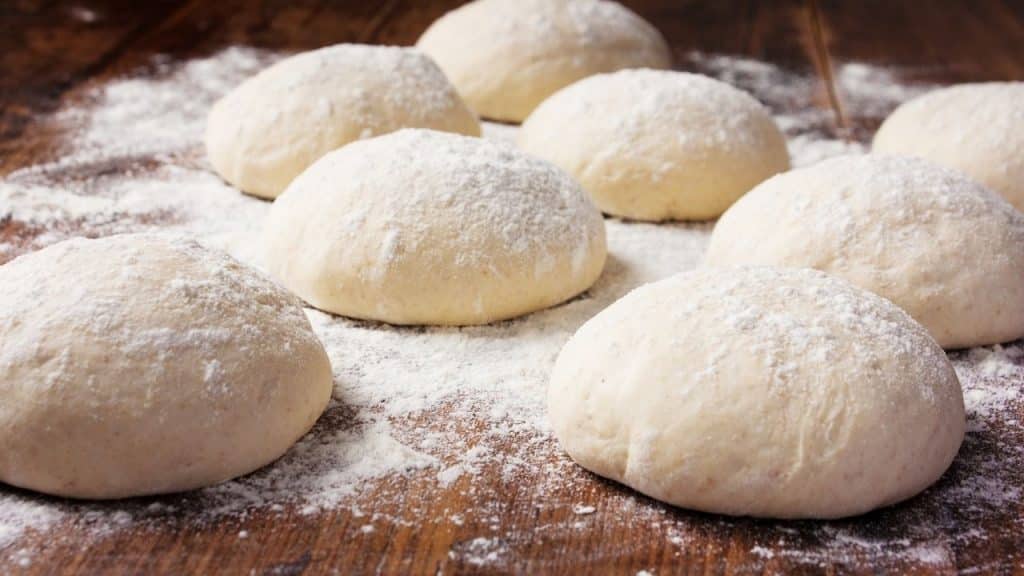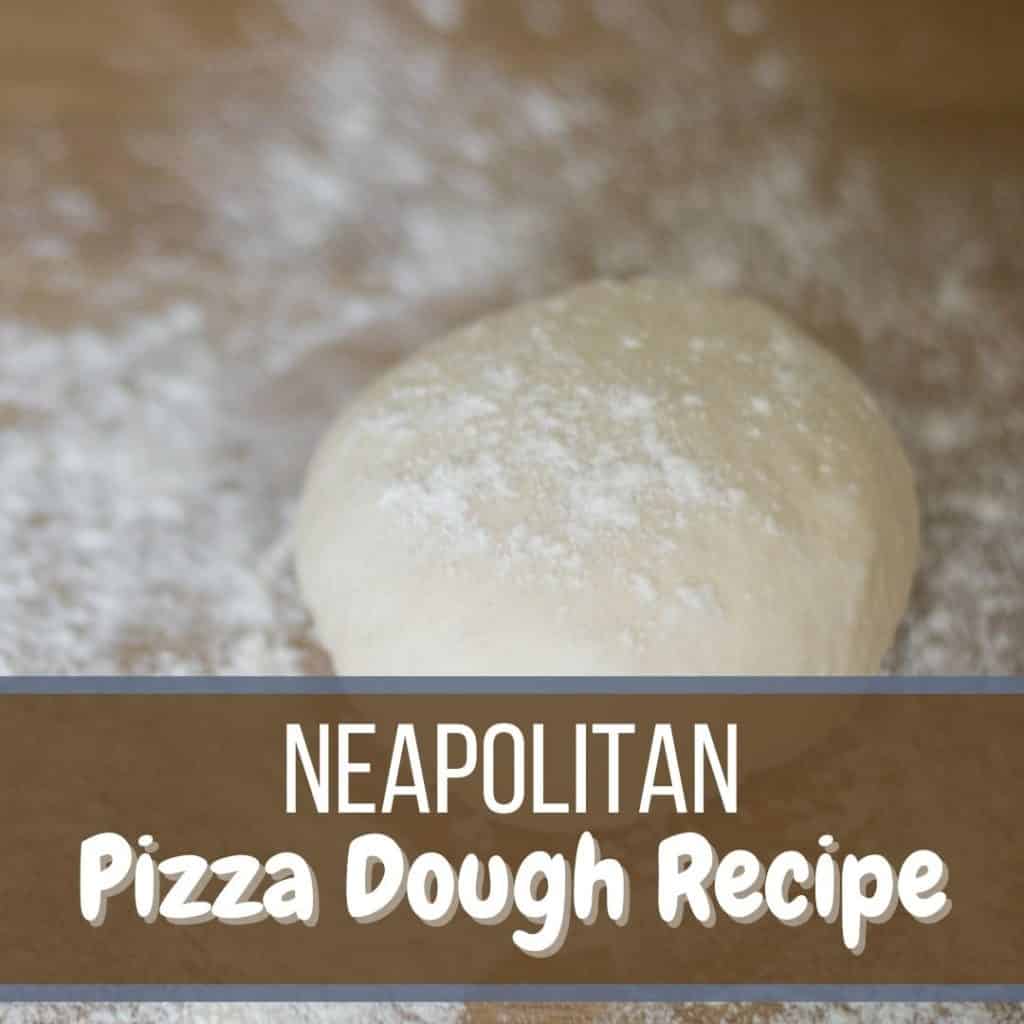
Looking for a pizza dough calculator that will help you make the best Neapolitan pizza?
I’ve tried to make it as easy and as simple to use as possible.
Below you’ll find the calculator, after that, I’ve gone into detail on what all of it means and how it use it.
Pizza Calculator
Your Recipe
| Water: g |
| Flour: g |
| Salt: g |
| Yeast: g |
What is a pizza dough calculator ?
This pizza dough calculator was created especially for creating Neapolitan pizza.
Neapolitan pizza is my go-to pizza. It’s light and full of flavour. If you use a pizza oven then you want to be making Neapolitan. (check out the best pizza ovens)
You can change any amount of the ingredients, it will always help you make a Neapolitan pizza.
I’ve designed this Pizza Dough Calculator to create a Neapolitan dough that is as close to traditional as possible. It focuses on helping to make sure you use the right ratios of ingredients. As well as following the right proving time and temperature.
Why do you need a Neapolitan pizza dough calculator?
Neapolitan Pizza Dough is notoriously difficult to get right.
If you find the process of doing the maths yourself too difficult, then this calculator is what you’re looking for.
The calculation tells you how much flour is needed per 100g of dough and by using that number, it’s possible to work out exactly how many ingredients are required.
You also input how long before cooking time that the dough needs to prove (or rise).
This allows the calculator to tell you exactly when it’ll be ready so there are no last-minute glitches on your important date!
How to use the pizza dough calculator
When it comes to using the pizza dough calculator, you can really change the texture and flavour by just adjusting some of the ingredients.
I’m going to break down each part of the calculator and explain how it helps you make your perfect Neapolitan dough.
Selecting The Right Ingredients
The first thing we need to do before looking at changing any of the ingredients is making sure we are using the right ingredients in the first place.
Flour
You want to try and use strong 00 flour, as it has higher protein. This makes the pizza dough softer and more elastic. Elasticity is important since it makes it easier for your to stretch and shape your pizza.
Water
You are fine to just use tap water. If you have poor quality water then you might want to replace this with filtered or bottled water. One thing that is is important is that the water is cold.
Salt
Now you can use all 3 types of salt, however, I’d recommend using fine sea salt. This is because flakes and rock salt do not dissolve as well and as quickly as fine sea salt. The last thing you want is bits of salt in your pizza dough.
Yeast
The great thing about Neapolitan dough is that you can use most types of yeast. With this Pizza Dough Calculator, the recipe will change depending on what yeast you decide to use.
The 3 types are;
- Intant Dried Yeast
- Active Dried Yeast
- Fresh Yeast
Dried yeast is the most common. It’s easy to work with and it has a great shelf life. Purists might stay you shouldn’t use instant/active but it does work just fine. I tend to use the instant easy bake yeast.
I don’t tend to use fresh yeast since it’s not as common, but if you can get hold of it then go for it. Another drawback is that it doesn’t last as long. Many people do prefer to go with fresh yeast as it does tend to add extra flavour.
If you want to be making authentic Neapolitan pizza, then you want to try and use fresh yeast.
There are other yeasts available, however, these are for more advanced pizza doughs and aren’t included in the calculator.
Changing The Pizza Dough Calculator
With the calculator, there are a few things you can change.
The biggest change that will affect the pizza dough is changing the temperature and proving time. These changes will have a big impact on the amount of yeast you’ll need.
I find it incredibly interesting learning about the different changes and what an impact this has on the dough. For example, adjusting the amount of water (hydration) can completely change the texture.
So to help with this, I’m going to go through the different things you can alter on the calculator. I’ll then go through what impact these will have on your pizza.
Dough Weight
Typically Neapolitan pizza dough weight will be 200-280g.
You want to update the dough weight based on the size of the pizza you want. If you want a larger pizza then you are going to want a heavier dough weight.
I normally aim for a dough weight of 250g, this gives a good 10″ pizza. If you want 12″+ then you might want to go for between 260-280g.
There is one thing that will impact how much you want your dough balls to weigh is the pizza crust.
If you’re wanting a crust that’s nice and puffy, the dough weight will need to be higher. This is because you’ll need more dough to stretch but have enough dough left over to form the crust.
The Pizza Dough Hydration
Hydration is something that many people struggle to get their heads around. It’s also a very important aspect when working out how many ingredients you will need.
It is a way to measure how much water was used in comparison to the amount of flour (in grams). If you want your dough wet, sticky, and soft, the hydration would be higher. If your dough has less water, it will be firmer and dryer.
Hydration has a massive impact on your dough. If it’s too high then it can be harder to work with. Too low then it is not as light and denser.
The calculator has a hydration range between 55% and 62%. Neapolitan typically falls within this range. You will see people recommending 65-70%, however, these do get harder to work so not something I would recommend for a beginner.
If you use lower hydration then it’s going to be easy to knead, ball and shape.
One thing you have to bear in mind is the impact the flour has on hydration. You see 00 wouldn’t need as high water content as strong bread flour.
It’s also worth noting that different brands have different protein content, which impacts how much water it absorbs. So it’s important to test different percentages.
Don’t feel like you have to go high with hydration. If you’re cooking your pizza in a pizza oven, the heat will help ensure that you get a light and fluffy dough regardless of the water content.
I did post an article on Pizza Dough Hydration, check it out to learn more about it. It’s really not as complicated as people think.
The key is to start low and test different hydrations until you find one that you’re happy with.
Salt Content
Many people are a little reluctant to add the right amount of salt to their pizza dough. Their afraid it might make the taste too salty. There’s no need to worry though. If
For a Neapolitan style dough, they recommend between 2% and 3%. This will have a subtle impact on the flavour.
Your taste buds are far more sensitive to salt than they are to other flavours. So just the right amount of it is enough.
I’d recommend you run through some tests. I tend to go in the middle and have my salt at an about 2.5%. Anything less and the flavour isn’t coming through. Anything more than it starts tasting too salty.
Proofing Time
Proofing time is one of those things that will impact your dough. It will have an impact on the texture, flavour, and how much it rises.
As you increase the time it’s going to decrease the amount of yeast you’re going to need. This is because you’re giving the yeast more time to work.
For authentic Neapolitan pizza, it should be left between 8-24 hours to prove. This does give you a little more flexibility on when you need your pizza ready.
It is often recommended to have a longer prove time. This gives your dough more flavour and a better texture.
It’s down to you and what you’re happy with. If it is roughly 8 hours, you’ll end up with a great tasting dough that isn’t too light or dense.
If your leaving it for 15+ then the flavour will be even more intense but will require less yeast.
Now you can create a pizza dough in just a couple of hours and it does taste fine. It requires around 7g of yeast, which is quite a lot. It’s also harder to work and won’t have the same flavour.
If you have time then id certainly try and leave it a minimum of 8 hours.
You can prove it for longer than 24 hours and many people do recommend this. Personally, I wouldn’t.
Not all flours can handle a prove of that length. It generally makes the dough a lot harder to work and runs the risk of the dough becoming weaker.
I personally find 12 or 24 hours works best.
If I’m going to have Pizza at 8 pm at night, I know I need to either make the dough at 87pm the night before or 8 am in the morning.
Remember the easier you can make it, the more enjoyable making homemade pizza will be.
Proofing Temperature
I often prove my pizza dough at room temperature.
This is because it increases the yeast activity and gives you an earlier rise in your dough.
If you’re looking to get your pizza ready for dinner then I’d recommend trying this technique out. You’ll have time for another prove too if you’re planning on making other pizzas for everyone else.
The best temp would be 13-33C / 55-91F, which has been shown to give you the biggest increase in yeast activity while being safe with all flours.
At the same time, many people do believe that cold proving in the fridge helps to develop the flavour better. You often have to use a little more yeast or leave it longer, as the yeast doesn’t develop as quickly when it’s cold.
Traditional Neapolitan pizza will prove at room temperature. Since I want to make this pizza dough calculator as simple as possible, I didn’t keep it at room temperature.
Having said that, there is a well-known saying that you should follow.
“What the dough, not the clock”
This is because, even though a recipe might say 24 hours. It might be ready in 20, depending on the room temperature.
The Number Of Pizzas Your Making
It’s surprising how many people don’t think about the number of pizzas they intend to make. This is naturally going to make a massive difference in the ingredients you will need.
This will naturally make the ingredients increase, however, it’s not just simply a case of doubling them.
I would always recommend accounting for 10% wastage as well.
Remember you can always store any leftover dough in the fridge and freezer. I usually make a couple of pizzas more than I need.
Final Thought
A pizza dough calculator is a great tool for figuring out how many ingredients you need to make the perfect homemade pizza.
It’s easy-to-use, fast and can help you figure out your next big dinner party menu! We hope that this article has been helpful in showing off what it does best – helping people find their perfect recipe based on an input or two.
Be sure to bookmark the page so that when the time comes, all you have to do is plug in a few numbers and get back tons of information about how much flour, yeast, salt and water you’ll need.







